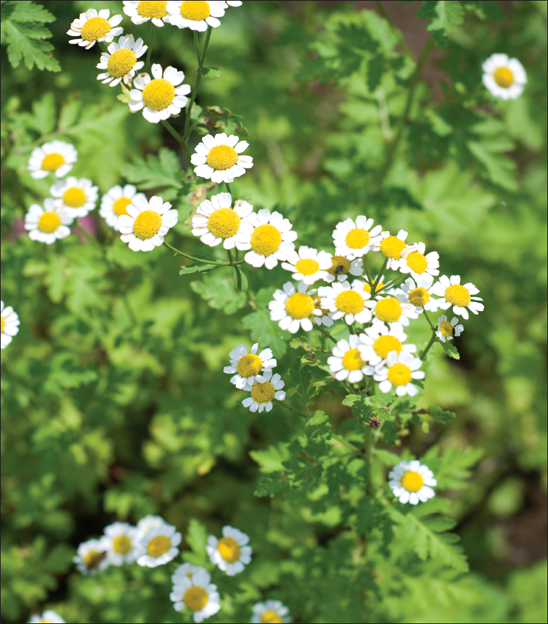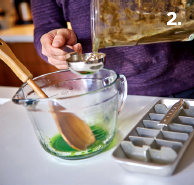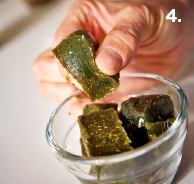
Feverfew
Feverfew is a member of the daisy family (Asteraceae) and features clusters of small white-petalled flowers with yellow centres. The plant gives off a strong, bug-deterring odour reminiscent of camphor. Feverfew is native to Europe but is also widespread throughout North America and Australia. The plant’s common name comes from the Latin for “fever reducer,” as that was one of its traditional uses. It’s also known as featherfew or bachelor’s buttons.
 Health Benefits
Health Benefits
Feverfew was used in ancient Greek medical practice as a remedy for inflammation and menstrual discomforts. Over the years, traditional herbalists have also used it to treat arthritis and aches and pains. As its name suggests, the herb was traditionally used to treat fevers, but this is no longer the case.
Today feverfew is commonly taken orally for the prevention of migraines. It is believed to reduce inflammation and prevent blood vessel constriction in the head and neck, and research suggests feverfew may reduce the incidence of headache attacks in patients who experience chronic migraines.
The plant’s most active ingredient is believed to be parthenolide, a compound that has anti-inflammatory properties.
DIFFICULTY
Easy
HARDINESS
Perennial in zones 5 to 9
TIME TO PLANT
Spring (or start seeds indoors 8 to 10 weeks before last frost date)
TIME TO HARVEST
Early summer (foliage)
LOCATION
Full sun
SOIL TYPE
Moist, well-drained
 Growing
Growing
A close relative of chrysanthemums, feverfew has been grown in gardens for centuries. While it’s mainly grown for medicinal purposes, this tender perennial is cherished for its foliage and its mounds of showy daisy-like flowers, which typically bloom from July to early fall.
Common Varieties: Tanacetum parthenium has many cultivars, including ‘Aureum’, ‘Flore Pleno’, ‘Golden Ball’, ‘Plenum’, ‘Snowball’, and ‘Wild’.
PLANT
Sow seeds indoors 8 to 10 weeks before last frost date. Plant the seedlings (or transplants from the garden centre) outdoors after the risk of frost. Choose a location with full sun and well-drained soil, or grow them in containers. Space plants 30 cm (12 inches) apart. Water deeply and infrequently until established.
What’s in a plant’s name? It can be confusing to identify plants if they have several common names, nicknames, marketing names, or regional names. The only reliable way to ensure you get the plant you’re looking for is to pay attention to the Latin name. Whether it’s called feverfew, featherfew, or bachelor’s button, the scientific name is Tanacetum parthenium. Look for it on the tag.
GROW
You can successfully grow feverfew with very little effort: it’s an insect- and disease-resistant plant. Deep infrequent watering, regular weeding, the occasional application of fertilizer, and frequent deadheading are the keys to success. When deadheading, consider removing some buds to promote leaf growth—but don’t strip all of the flowers! Feverfew will easily self-sow if you leave some flowers to dry on the plants.
In late fall or early spring, cut the plant back to the ground while it is dormant.
HARVEST
Harvest when in bloom or when foliage has matured. Wash the plants the day before harvesting by watering their foliage in the morning. The next morning after the dew has dried, cut the foliage, stems and all, removing no more than half the plant at a time. Use a sharp, clean knife and do not tear the stems.
STORE
Dry feverfew by hanging stems in a dark, dry place for up to 2 weeks (see “Drying Herbs at Home” on page 365). Space them out to increase airflow and minimize rot. After drying, store feverfew in an airtight container out of direct light.
 Put It to Work
Put It to Work
Prone to migraines? Say hello to feverfew Jell-O!
Feverfew may be nature’s answer to unbearable migraine pain, but the research seems to suggest you’ll need to take it every day for it to be most effective. You also require about 100 milligrams per day for 4 to 6 weeks before it starts to really work. I admit this can be something of an ordeal. What’s more, it tastes horrible. And you need to take it in the whole-leaf form, which is particularly foul-tasting. You’ve been warned.
Fortunately, there is a solution that makes this remedy more palatable. This recipe is adapted from herbalist James Green.
You’ll need two BPA-free ice-cube trays. For each cube in your trays harvest 2 large feverfew leaves. Wash and place them in a blender. Boil enough water to fill one-and-a-half trays and add the boiling water to the blender. Pulse until well combined, with the leaves evenly dispersed in the boiling water.
In a bowl, add a box of Jell-O powder (I recommend a citrus flavour to mask the taste of the feverfew) (1). Pour the feverfew mixture into the bowl and stir for 2 to 3 minutes (2), making sure that the gelatin is fully dissolved. Add an additional  cup of very cold water and stir well.
cup of very cold water and stir well.


Fill each compartment in both ice-cube trays with the Jell-O mixture (3). Refrigerate for about 2 hours to set. The texture will be squishy (4).


Consume one Jell-O cube every day. You won’t love them, but you will love not having headaches!
 Fast Forward
Fast Forward
Fast forward to the health food store to purchase Genestra feverfew capsules or equivalent. Follow the instructions on the label.
 Cautions
Cautions
Known side effects of feverfew are usually mild. Ulcers in the mouth, swelling of the lips, tongue irritation, and bleeding of the gums (primarily from chewing the leaves) as well as loss of taste have been reported, but all are reversible. In rare instances, sensitivity to light, nausea, abdominal bloating, and heartburn have also been recorded.
If you have been taking feverfew regularly for more than a week, do not stop abruptly or you may experience headache, fatigue, anxiety, and sleeplessness, or stiffness of the muscles or joints.
Pregnant women should not take feverfew.
